F4U Corsair
Genesis & Design
En février 1938, l'US Navy fait un appel à propositions pour un nouveau chasseur embarqué. Vought met sur pied une équipe sous la direction de Rex Beisel. L'idée de départ de Beisel était de concevoir la cellule la plus compact possible pour accueillir le moteur en étoile Pratt et Whitney Double Wasp de 1850 CV. La Navy était une grande supportrice des moteurs radiaux à refroidissement par air, car ils supportaient mieux les affres des combats aériens et leur grande fiabilité générale, en comparaison des moteurs à refroidissement liquide. Le trait le plus particulier du V-166B, est son aile de mouette coudée (ou inversée, en W). Cette disposition particulière permettait de surélever le nez, sans installer un long train d'atterrissage (celui-ci pivotait sur 90° pour se déployer ou se ranger), afin d'accueillir la plus grande hélice possible (une Hamilton-Standard Hydromatic tri-pales). Une grande hélice permettait de tirer le meilleur de la grande puissance du moteur. La disposition des ailes permettait une fois pliées dans les hangars des porte-avions, d'occuper moins d'espace en hauteur. Autre avantage, le pilote pouvait seul activer l'opération de pliage ou de dépliages des ailes, alors que précédemment, cela nécessitait l'intervention manuelle du personnel de pont.
In February 1938, the Navy made a order for proposals for a new carrier
based fighter. Vought set up a team under the direction of Rex Beisel.
The idea of Beisel was to design the more compact possible airframe to
accommodate the radial Pratt & Whitney Double Wasp, 1850 HP engine.
The Navy was a great supporter of air-cooled radial engines, because they
better supported the impacts of aerial combat and their general reliability,
compared to liquid cooling engine . The most distinctive feature of the
V-166B, is its cranked gull-wing (inverted W-Wings). This particular provision
raised the nose, without installing a long landing gear (it turned through
90° to deploy or to store), in order to accommodate the largest possible
propeller (a three-bladed Hamilton-Standard Hydromatic). A large propeller
made it possible to got the most of the great power of the engine. The
provision of the wings allowed once folded in carrier hangars, occupying
less space in height. Another advantage, the pilot could only activate
the operation of folding or unfolding of the wings, while previously,
this required the manual intervention of the deck personnel.
 |
XF4U-1 |
src: Wikipédia |
La Navy, commande un prototype en juin 1938 sous le nom de XF4U-1 et ce dernier fera son premier vol en mai 1940. L'armement était composé d'un mix de mitrailleuses de 12.7 mm (.50) et de 7.62 mm (.30) disposé dans les ailes et le capot. En octobre 1940, en vol en palier, le XF4U-1 est le premier chasseur américain a être crédité d'une vitesse de 650 km/h. Comme pour d'autres avions américains (P-38, P-47), le XF4U-1 disposait d'ailes épaisse en coupe transversale mais à faible flux laminaire qui causaient la formation précoce d'ondes de choc dans le flux d'air sur le dessus des ailes à vitesse supersonique en altitude ou de piquée. Ces ondes de chocs détérioraient la portance des ailes et provoquaient une plongée de plus en plus raide et rapide d'où le pilote ne pouvait sortir qu'une fois à une altitude où l'air était plus dense. C'était une expérience assez terrifiante et qui pouvait être fatale pour un novice, voir même un pilote confirmé si il ne disposait comme en montagne d'assez d'altitude pour permettre une récupération de l'appareil.
The Navy, command a prototype in June 1938 as the
XF4U-1 and it will make its first flight in May 1940. The armament consisted
of a mix of machine guns of 12.7 mm (. 50) and 7.62 mm (. 30) in the wings
and cowl. In October 1940, in level flight, the XF4U-1 is the first American
fighter to be credited of a speed of 650 km/h. As for other aircraft (P-38,
P-47), the XF4U-1 had thick wings in cross-section but low laminar flow
that caused the early formation of shock waves in the flow of air on the
top of the wings at supersonic speed in high altitude, high speed dives.
These shock waves deteriorating the lift of the wings and caused a increasingly
steeper and faster dive from where the pilot could get out only once at
an altitude where the air was denser. It was a frightening experience,
and which could be fatal for a novice, see even a confirmed pilot if he
did as a mountain of enough altitude to permit recovery.
|
 |
Cockpit evolution |
|
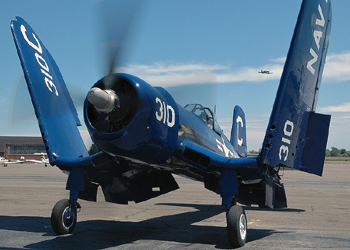 |
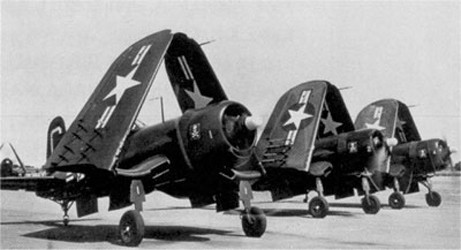 |
Folding W-Wings.
|
|
src: Wikimedia |
src: Classic
Fighters |
Boards |
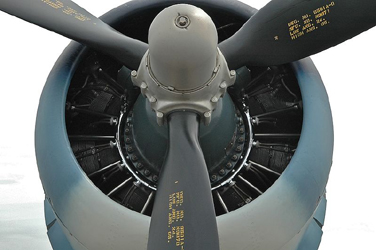 |
 |
 |
Pratt &
Whitney R-2800-8 2000 hp "Double Wasp"
|
Command Pannel |
|
src: Wikimedia |
src: Wikipédia |
src: Classic
Fighters |
Pour y remédier aux problèmes initiaux, on installa un moteur plus puissant, un R-2800-8 de 2000 CV avec un système d'approvisionnement revisité. Cela a eut pour effet de déplacer le poste de pilotage vers l'arrière (qui au cours de la production sera doté d'une nouvelle verrière "bulle"), pour maintenir un bon centre de gravité. Cette modification aura cependant une conséquence assez fâcheuse. En effet lors que le nez était en position haute comme lors de l'atterrissage, le pilote était quasi aveugle ! Pour cette raison l'appareil fut jugé impropre pour opérer à partit d'un porte-avion ce qui mit en terme (momentané) à sa carrière d'avion embarqué, avant même qu'elle commence. Le XF4U-1 sera cependant bien accepté pour la production sous le nom de F4U-1, le 30 juin 1941 (commande de 584 appareils), mais comme chasseur basé à terre au sein du Corps des Marines et non de la Navy. Le Corsair perdit même son système d'ailes repliables avec le F4U-1A, même s'il le récupérera ensuite. L'armement définitif adopté était composé de 6 mitrailleuses de 12.7 mm (.50) toutes installées dans les ailes. Les premiers F4U-1's furent livrés en juin 1942 et furent déclarés aptes au combat en décembre. Un total de 12583 appareils sortiront (jusqu'en 1952), des lignes de montage de Chance-Vought à Stratford (Connecticut) et Dallas (Texas), Goodyear à Akron (Ohio) et Brewster Aeronautical à Warminster (Pennsylvanie). Le Corsair (nom encore une fois donné par les Britanniques) fut également livrés aux Royaumes-Unis et la Nouvelle-Zélande au cours du conflit.
To remedy the initial problems, it installed a more powerful engine, a R-2800-8 of 2000 HP with a fuel system revisited. What caused the displacement toward the rear of cockpit (which during production will be equipped with a new "bubble" canopy), , to maintain a good center of gravity. However, this change will be a rather unfortunate consequence. Indeed when the nose was in the up position as during landing, the pilot was almost blind! For this reason the aircraft was deemed unfit to operate from an aircraft carrier what cancelled (momentary) its career of carrier-based aircraft, even before it begins. The XF4U-1 will be however accepted for production under the name of F4U-1, 30 June 1941 (584 units ordered), but as a land based fighter within the Marine Corps, not the Navy. The Corsair lost even its system of folding wings with the F4U-1A, even if it will recover then. The final armament adopted consisted of 6 machine guns of 12.7 mm (. 50) all installed in the wings. The first F4U-1's were delivered in June 1942 and were declared fit to fight in December. A total of 12583 machines will come out (until 1952), of the Assembly lines of Chance-Vought at Stratford (Connecticut) and Dallas (Texas), Goodyear at Akron (Ohio), and Brewster Aeronautical at Warminster (Pennsylvania). The Corsair (name still once given by the British) was also delivered to the United Kingdoms and New Zealand during the conflict.
 |
 |
F4U-1 Corsair assembly
|
|
src: WWII
Vehicles |
src: Wikipédia |
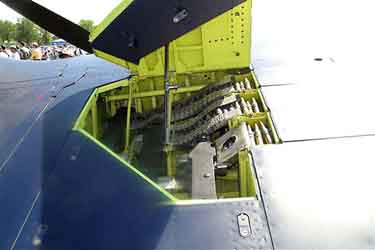 |
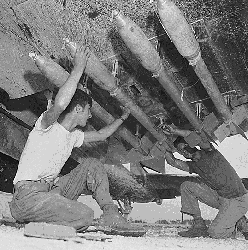 |
Ammo provisioning of the 3 x .50cal Browning
MG.
|
8 × 5 in (12.7 cm) High Velocity Aircraft
Rockets
|
src: theschale |
src: Aviation
History |
 |
 |
src: ?
|
|
Drawings |
Sources:
